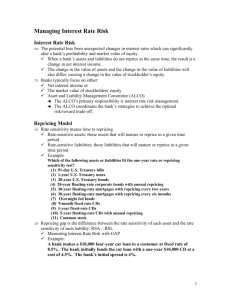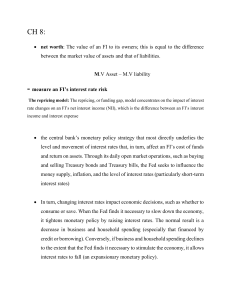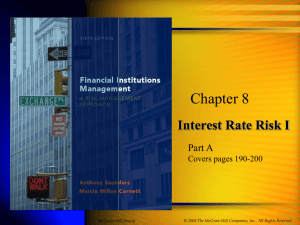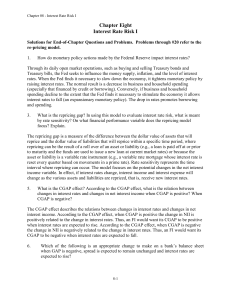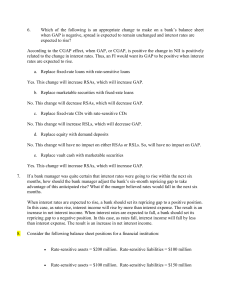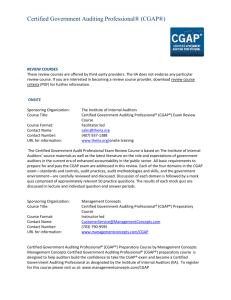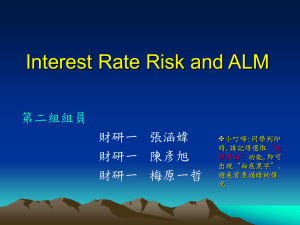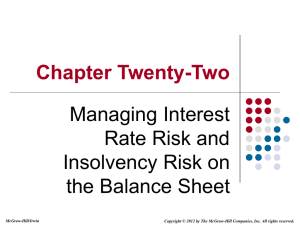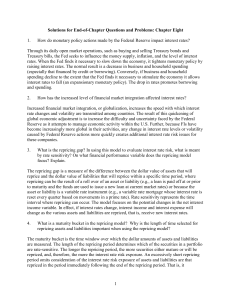Solutions for End-of-Chapter Questions and Problems
advertisement
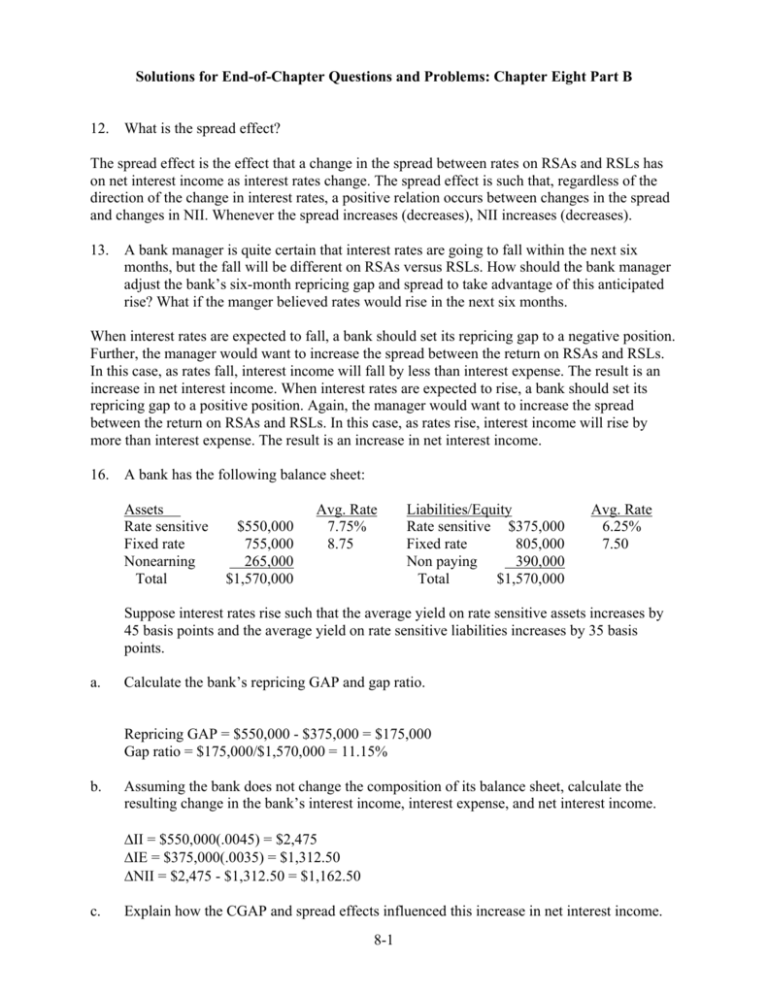
Solutions for End-of-Chapter Questions and Problems: Chapter Eight Part B 12. What is the spread effect? The spread effect is the effect that a change in the spread between rates on RSAs and RSLs has on net interest income as interest rates change. The spread effect is such that, regardless of the direction of the change in interest rates, a positive relation occurs between changes in the spread and changes in NII. Whenever the spread increases (decreases), NII increases (decreases). 13. A bank manager is quite certain that interest rates are going to fall within the next six months, but the fall will be different on RSAs versus RSLs. How should the bank manager adjust the bank’s six-month repricing gap and spread to take advantage of this anticipated rise? What if the manger believed rates would rise in the next six months. When interest rates are expected to fall, a bank should set its repricing gap to a negative position. Further, the manager would want to increase the spread between the return on RSAs and RSLs. In this case, as rates fall, interest income will fall by less than interest expense. The result is an increase in net interest income. When interest rates are expected to rise, a bank should set its repricing gap to a positive position. Again, the manager would want to increase the spread between the return on RSAs and RSLs. In this case, as rates rise, interest income will rise by more than interest expense. The result is an increase in net interest income. 16. A bank has the following balance sheet: Assets Rate sensitive Fixed rate Nonearning Total $550,000 755,000 265,000 $1,570,000 Avg. Rate 7.75% 8.75 Liabilities/Equity Rate sensitive $375,000 Fixed rate 805,000 Non paying 390,000 Total $1,570,000 Avg. Rate 6.25% 7.50 Suppose interest rates rise such that the average yield on rate sensitive assets increases by 45 basis points and the average yield on rate sensitive liabilities increases by 35 basis points. a. Calculate the bank’s repricing GAP and gap ratio. Repricing GAP = $550,000 - $375,000 = $175,000 Gap ratio = $175,000/$1,570,000 = 11.15% b. Assuming the bank does not change the composition of its balance sheet, calculate the resulting change in the bank’s interest income, interest expense, and net interest income. ΔII = $550,000(.0045) = $2,475 ΔIE = $375,000(.0035) = $1,312.50 ΔNII = $2,475 - $1,312.50 = $1,162.50 c. Explain how the CGAP and spread effects influenced this increase in net interest income. 8-1 The CGAP affect worked to increase net interest income. That is, the CGAP was positive while interest rates increased. Thus, interest income increased by more than interest expense. The result is an increase in NII. The spread effect also worked to increase net interest income. The spread increased by 10 basis points. According to the spread affect, as spread increases, so does net interest income. 17. A bank has the following balance sheet: Assets Rate sensitive Fixed rate Nonearning Total $550,000 755,000 265,000 $1,570,000 Avg. Rate 7.75% 8.75 Liabilities/Equity Rate sensitive $575,000 Fixed rate 605,000 Nonpaying 390,000 Total $1,570,000 Avg. Rate 6.25% 7.50 Suppose interest rates fall such that the average yield on rate sensitive assets decreases by 15 basis points and the average yield on rate sensitive liabilities decreases by 5 basis points. a. Calculate the bank’s CGAP and gap ratio. CGAP = $550,000 - $575,000 = -$25,000 Gap ratio = -$25,000/$1,570,000 = -1.59% b. Assuming the bank does not change the composition of its balance sheet, calculate the resulting change in the bank’s interest income, interest expense, and net interest income. ΔII = $550,000(-.0015) = -$825 ΔIE = $575,000(-.0005) = -$287.50 ΔNII = -$825 – (-$287.50) = -$537.50 c. The bank’s CGAP is negative and interest rates decreased, yet net interest income decreased. Explain how the CGAP and spread effects influenced this decrease in net interest income. The CGAP affect worked to increase net interest income. That is, the CGAP was negative while interest rates decreased. Thus, interest income decreased by less than interest expense. The result is an increase in NII. The spread effect, on the other hand, worked to decrease net interest income. The spread decreased by 10 basis points. According to the spread affect, as spread decreases, so does net interest income. In this case, the increase in NII due to the spread effect was dominated by the decrease in NII due to the spread effect. 18. The balance sheet of A. G. Fredwards, a government security dealer, is listed below. Market yields are in parentheses, and amounts are in millions. Assets Cash 1-month T-bills (7.05%) 3-month T-bills (7.25%) 2-year T-notes (7.50%) Liabilities and Equity Overnight repos Subordinated debt 7-year fixed rate (8.55%) $20 150 150 100 8-2 $340 300 8-year T-notes (8.96%) 5-year munis (floating rate) (8.20% reset every 6 months) Total assets 200 50 $670 Equity Total liabilities and equity 30 $670 a. What is the repricing gap if the planning period is 30 days? 3 month days? 2 years? Repricing gap using a 30-day planning period = $150 - $340 = -$190 million. Repricing gap using a 3-month planning period = ($150 + $150) - $340 = -$40 million. Reprising gap using a 2-year planning period = ($150 + $150 + $100 + $50) - $340 = $110 million. b. What is the impact over the next three months on net interest income if interest rates on RSAs increase 50 basis points and on RSLs increase 60 basis points? ΔII = ($150m. + $150m.)(.005) = $1.5m. ΔIE = $340m.(.006) = $2.04m. ΔNII = $1.5m. – ($2.04m.) = -$.54m. c. What is the impact over the next two years on net interest income if interest rates on RSAs increase 50 basis points and on RSLs increase 75 basis points? ΔII = ($150m. + $150m. + $100 + $50)(.005) = $2.25m. ΔIE = $340m.(.0075) = $2.55m. ΔNII = $2.25m. – ($2.55m.) = -$.30m. d. Explain the difference in your answers to parts (b) and (c). (missing sentence) For b, the CGAP is negative which alone would result in a reduction in NII and the spread effect just makes the reduction larger (more negative). For c, the CGAP is positive and rates increased. If there were no spread effect, that would result in an increase in NII. However, the spread effect was large enough to offset the positive CGAP, so the NII decreased. 19. A bank has the following balance sheet: Assets Rate sensitive Fixed rate Nonearning Total $225,000 550,000 120,000 $895,000 Avg. Rate 6.35% 7.55 Liabilities/Equity Rate sensitive $300,000 Fixed rate 505,000 Nonpaying 90,000 Total $895,000 Avg. Rate 4.25% 6.15 Suppose interest rates rise such that the average yield on rate sensitive assets increases by 45 basis points and the average yield on rate sensitive liabilities increases by 35 basis points. 8-3 a. Calculate the bank’s repricing GAP. Repricing GAP = $225,000 - $300,000 = -$75,000 b. Assuming the bank does not change the composition of its balance sheet, calculate the net interest income for the bank before and after the interest rate changes. What is the resulting change in net interest income? NIb = ($225,000(.0635) +$550,000(.0755)) – ($300,000(.0425) + $505,000(.0615)) = $55,812.50 - $43,807.50 = $12,005 NIa = ($225,000(.0635 + .0045) +$550,000(.0755)) – ($300,000(.0425 + .0035) + $505,000(.0615)) = $56,825 - $44,857.50 = $11,967.50 ΔNII = $11,967.50 - $12,005 = -$37.5 c. Explain how the CGAP and spread effects influenced this increase in net interest income. The CGAP is negative and rates increased, so that effect alone would result in a reduction of NII. Since the rates for liabilities increased less than those for assets, the spread effect alone would result in an increase in NII. The CGAP effect was larger, so NII decreased very slightly. 20. What are some of the weakness of the repricing model? How have large banks solved the problem of choosing the optimal time period for repricing? What is runoff cash flow, and how does this amount affect the repricing model’s analysis? The repricing model has four general weaknesses: (1) It ignores market value effects. (2) It does not take into account the fact that the dollar value of rate sensitive assets and liabilities within a bucket are not similar. Thus, if assets, on average, are repriced earlier in the bucket than liabilities, and if interest rates fall, FIs are subject to reinvestment risks. (3) It ignores the problem of runoffs, that is, that some assets are prepaid and some liabilities are withdrawn before the maturity date. (4) It ignores income generated from off-balance-sheet activities. Large banks are able to reprice securities every day using their own internal models so reinvestment and repricing risks can be estimated for each day of the year. Runoff cash flow reflects the assets that are repaid before maturity and the liabilities that are withdrawn unsuspectedly. To the extent that either of these amounts is significantly greater than expected, the estimated interest rate sensitivity of the bank will be in error. 8-4
